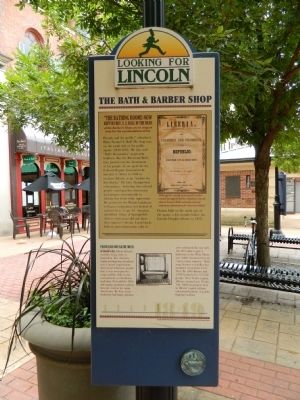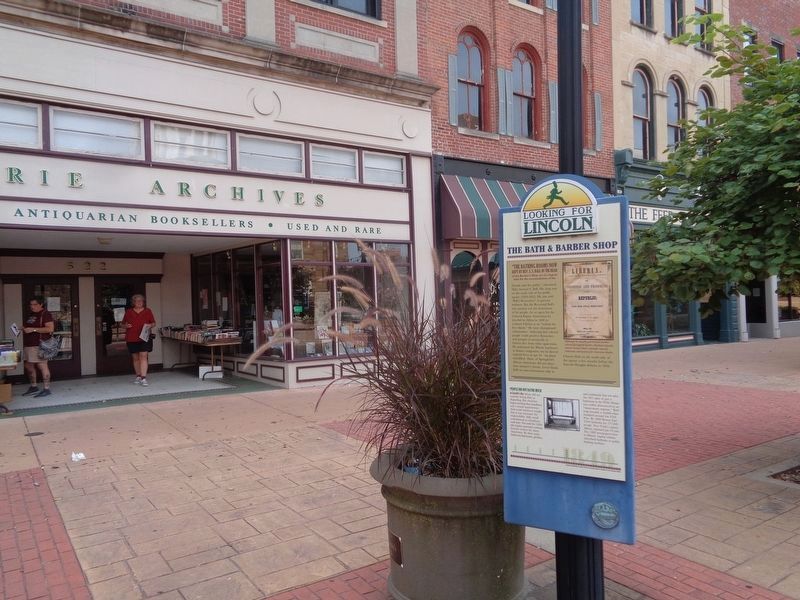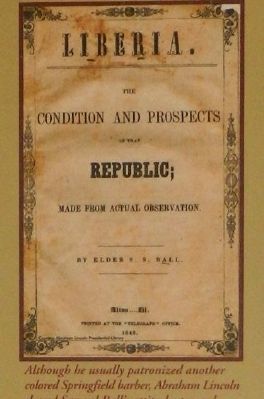Springfield in Sangamon County, Illinois — The American Midwest (Great Lakes)
The Bath & Barber Shop
Looking for Lincoln
"The bathing rooms now kept by Rev. S. S. Ball in the rear of his Barber's Shop are in elegant trim for the accommodation of his Friends and the public," advertised Elder Samuel S. Ball.His shop was on the south side of the public square (1849-1852). He also sold "Ball Restorative" to prevent baldness. But the Reverend Ball's true passion was the betterment of his people. As an agent for the Colored Baptist Association he traveled to Africa in 1848 to evaluate Liberia as an "asylum for free blacks." He later championed colonization---believing that colored people could practice democracy and prosper economically in Liberia free from white oppression. He petitioned the Illinois legislature to finance emigration, but he died of typhoid fever at age 42---his plans unfulfilled. Many of Springfield's African Americans did not share their minister's dream. Local blacks held an anti-colonization rally in Clinton Hall on the north side of the square a few months before the Lincoln-Douglas debates in 1858.
People did not bathe much in Lincoln's day. many did not consider being dirty as degrading. But churches began teaching that cleanliness was a moral requirement. And social reformers taught that it was necessary for respectability. Still, social commitment to cleanliness took time. Not until the 1850s did regular personal
washing become routine for many Americans. By then many bedrooms had basins, pitchers, and washstands (but not tubs). An 1851 plan to put a bathroom in the White House was widely denounced as an "unnecessary expense." Bath soap became a middle-class standard around the Civil War. By 1860 Boston had 3,910 bathtubs for 177,840 people. New York's capital, Albany reported just 19 tubs. The 1860 newspapers here in Illinois' capital seldom advertised bathtubs or public bathing facilities.Topics and series. This historical marker is listed in these topic lists: African Americans • Industry & Commerce • Notable Places. In addition, it is included in the Former U.S. Presidents: #16 Abraham Lincoln, and the Looking for Lincoln series lists. A significant historical year for this entry is 1848.
Location. 39° 48.032′ N, 89° 38.904′ W. Marker is in Springfield, Illinois, in Sangamon County. Marker can be reached from E. Adams Street west of South 6th Street. Marker is located between 5th and 6th Streets, in front of the Old State Capitol. Touch for map. Marker is in this post office area: Springfield IL 62701, United States of America. Touch for directions.
Other nearby markers. At least 8 other markers are within walking distance of this marker. C. M. & S. Smith Store (here, next to this marker); Stephen A. Douglas (here, next to this marker); Adams Street (here, next to this marker); Potawatomi Trail of Death (a few steps from this marker); Abraham Lincoln - Eighth Judicial District (a few steps from this marker); President-Elect Abraham Lincoln (a few steps from this marker); 1859-1911 (a few steps from this marker); Departure Point of The Donner Party (a few steps from this marker). Touch for a list and map of all markers in Springfield.
Credits. This page was last revised on November 14, 2020. It was originally submitted on October 22, 2011, by Bill Pfingsten of Bel Air, Maryland. This page has been viewed 674 times since then and 28 times this year. Photos: 1. submitted on October 22, 2011, by Bill Pfingsten of Bel Air, Maryland. 2. submitted on November 14, 2020, by Jason Voigt of Glen Carbon, Illinois. 3. submitted on October 22, 2011, by Bill Pfingsten of Bel Air, Maryland.


